Scouting Remotely with Google Earth
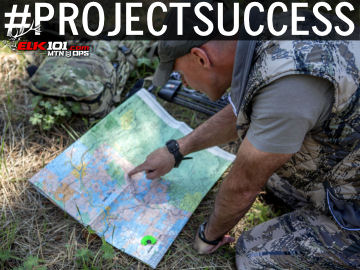
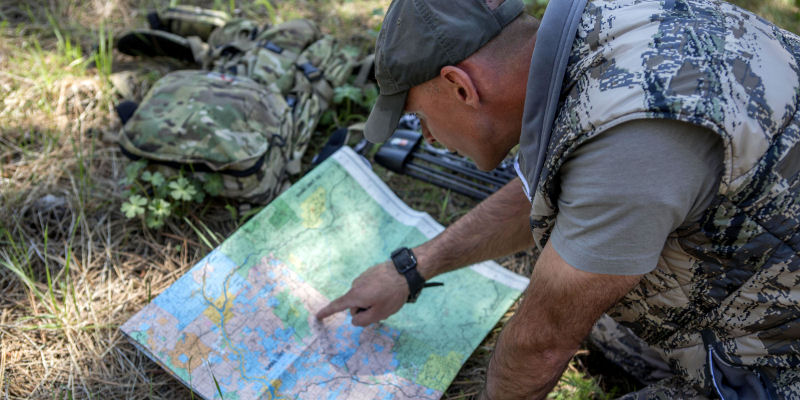
Wow! Thank you all so much for the amazing response to last week’s question! There were well over 200 responses in the comments area as I started typing this email, and I received an equal number of responses by email over the weekend! I have selected the 20 winners for the diaphragm elk calls….check the list below to see if you won.
As I mentioned last week, the reason I was asking the question (What is the one thing you want to learn – or improve upon – when it comes to being a better elk hunter?) was to ensure that I had covered everything for my upcoming elk hunting project release. The good news is that there were only 2 questions out of nearly 500 responses that weren’t addressed in the project! And the even better news is that the top 3 responses are not only covered in the project, but covered in amazing detail and clarity.
Just to recap, the top 3 responses to the question from last week can be summarized like this:
- How do I effectively scout from a remote location (using Google Earth, etc.)?
- How do I learn to use calling more effectively?
- How do I learn elk behavior to find elk more consistently in the field?
I want to tackle the first question today: How do I effectively scout from a remote location (using Google Earth, etc.)?
Scouting is vital to success. There is an area here in Idaho that I have hunted for a long time, and I never really felt the need to scout the area to find elk. It took a few years of hunting the area to get to this point, but eventually, I knew I could literally just show up the first week of September and be into elk from the first morning. I knew where the common rutting areas were, where the elk went for water, where they bedded down for the day, etc. There was really no need to scout. However, I loved seeing elk on trail cameras, so each summer, I would hang 3-4 trail cameras in this area and keep tabs on the elk – mainly the cows. Through this process, I was able to dial in even more detailed information on the habits and behavior of the elk in this area, but I never felt that my scouting was adding to my success.
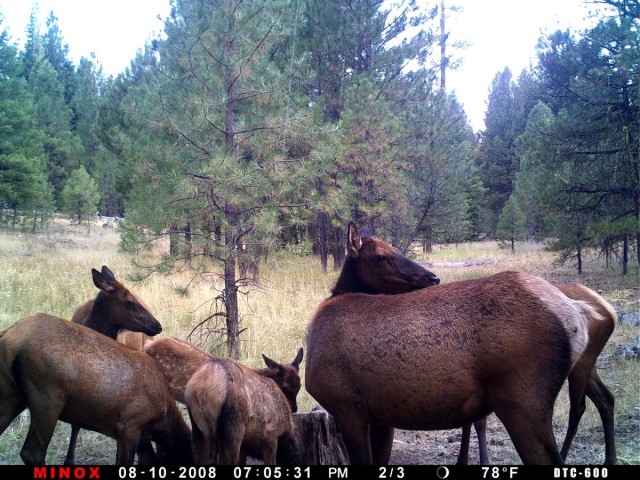
One summer several years ago, I went up for my traditional retrieval of the trail cameras the week before season opened. The cameras had been out for almost 3 months, and to my surprise, I found most of the cameras had captured very limited elk activity. I had 4 cameras in varied locations, and there were fewer than 20 elk on all the cameras combined! I was confused, but I knew the elk would be there. Why wouldn’t they? For some reason, they had just eluded the trail cameras. However, I was certain I would find them once season opened and the bulls started bugling, just like I had for the previous 10 years. Boy, was I wrong!
I couldn’t find fresh elk sign during the season, and we only heard two bugles in the first 6 days. Finally, on Day 7, and in the 4th area we had relocated to, we called in our first bull. Fortunately, I was able to connect on that bull, but our elk season had almost gotten away from us and left us with nothing more than tag soup and utter frustration. So, what does this story and the findings on my trail cameras have to do with remote scouting? Nothing. But, I had spent that summer looking over Google Earth while wasting away the slow days until elk season arrived. In that scouting from home, I had located 4 backup areas to check out just in case we “tagged out early” and had some extra time to check out new areas. I was sure glad those areas were marked on my GPS on Day 7!
So, what is my point to this? I had spent a fair amount of gas money and time throughout the summer driving back and forth between home and my local hunting area to set trail cameras, check trail cameras, etc. However, I had spent limited time (and no money) scouring Google Earth, and that was what eventually saved our season. Since that time, I have changed my approach slightly, and I now do 90% of my scouting from home. If I am able to make it to the area I am going to hunt ahead of the season, I do it simply to verify what I researched from home. And there are several resources besides Google Earth for doing that research.
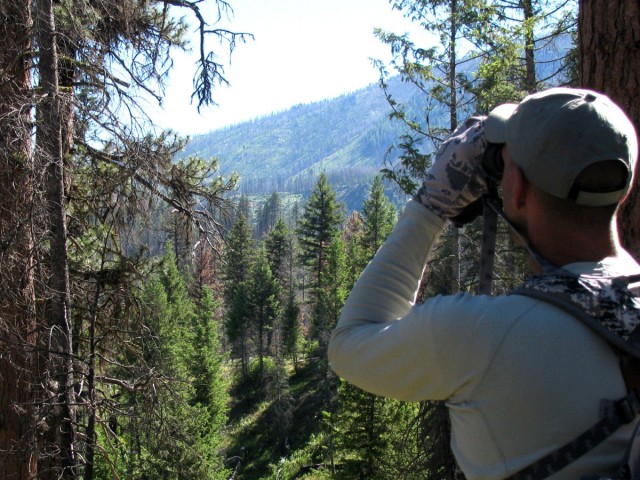 With the introduction of out-of-state elk hunts into my annual plans a few years ago, this remote research became even more valuable. In fact, on my first trip to hunt elk as a non-resident, I was amazed at how well I knew the area I was hunting, even though I had never been there before. In fact, we stepped out of the truck our first morning in this new area and had multiple bulls bugling before we even started hiking! The best part of that remote scouting experience was knowing right where to go to find the most likely bedding areas, as well as usable sources of water and remote pockets where the elk retreated to when they were pressured. We were into elk every single day! Coincidentally, I was more confident in my abilities to find elk on that hunt than I was in finding elk in the area I had been hunting close to home for the previous 10 years!
With the introduction of out-of-state elk hunts into my annual plans a few years ago, this remote research became even more valuable. In fact, on my first trip to hunt elk as a non-resident, I was amazed at how well I knew the area I was hunting, even though I had never been there before. In fact, we stepped out of the truck our first morning in this new area and had multiple bulls bugling before we even started hiking! The best part of that remote scouting experience was knowing right where to go to find the most likely bedding areas, as well as usable sources of water and remote pockets where the elk retreated to when they were pressured. We were into elk every single day! Coincidentally, I was more confident in my abilities to find elk on that hunt than I was in finding elk in the area I had been hunting close to home for the previous 10 years!
My point is this: there is no reason for you to be overwhelmed or lack confidence in your abilities to get into elk, even if you aren’t able to scout an area throughout the summer. If you do your homework – even from hundreds of miles away – you can realistically expect to be into elk within a day or two of arriving in a new area.
When it comes to scouting for elk, I definitely feel it plays a role in my success. However, I give very little credit for that success to actual “in-the-field scouting”. The majority of the credit when it comes to scouting for elk is directed instead to being able to effectively scout an area from home. For the past few years, I have looked forward to out-of-state hunts in new areas more than I’ve looked forward to going back to familiar ground. There is so much elk hunting country out there, and much of it gets very little pressure from other hunters. And I’ve found that I can locate much of that country from home.
I know what you’re saying now….how do we do it?!?! Right? It’s really very simple. I look for 4 things that are all easily identifiable on Google Earth: food, water, bedding areas, and limited access. If I can find those 4 things in close proximity to each other, I am pretty confident that I will be able to find elk once I show up in the area. It might take a couple backup areas before I find a hotspot, but since those areas are already programmed into my GPS when I show up, I can bounce from one area to the next in a matter of hours – not days or weeks like it would take if I was scouting blindly.
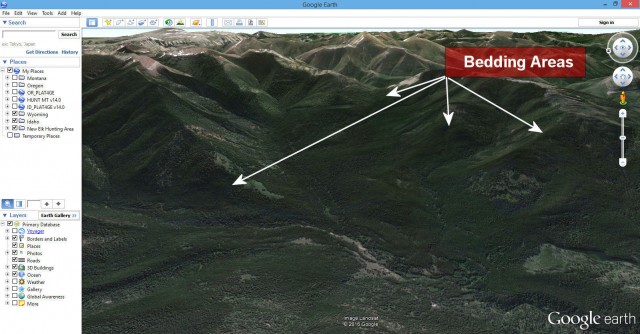 One of the most commonly asked sub-questions on this topic is how to identify the features of food, water, and bedding areas from Google Earth. For me, those features really jump out as I scan an area from a high perspective. First, I look for bedding areas by locating the dark slopes on the north sides of the terrain. I scan a huge area (30-40 square miles) and look for true, north-facing slopes that will provide cover and shade for the elk. Once I’ve identified the top 8-10 north-facing slopes in an area, I zoom in and move to the next step – finding food.
One of the most commonly asked sub-questions on this topic is how to identify the features of food, water, and bedding areas from Google Earth. For me, those features really jump out as I scan an area from a high perspective. First, I look for bedding areas by locating the dark slopes on the north sides of the terrain. I scan a huge area (30-40 square miles) and look for true, north-facing slopes that will provide cover and shade for the elk. Once I’ve identified the top 8-10 north-facing slopes in an area, I zoom in and move to the next step – finding food.
I look for food sources in somewhat close proximity to the north-facing bedding areas. For me, food sources are identified by open ridges, open meadows, clear-cuts, or transitional areas on the edge of burns. I don’t worry too much about what kind of food will be found there, but I have come to recognize that elk prefer to browse along these open areas early in the morning and late in the evening. With two of the three features now identified, I look for sources of water nearby.
Water isn’t always readily identifiable, but really green areas usually are. So, I look for springs (bright green areas, especially on north-facing slopes), creeks, waterholes, wallows, lakes….anything that might signify that there is water close by. One thing to keep in mind is that if you are looking at Google Earth imagery from April, it isn’t going to give you a good idea of what water conditions are going to be like in the area in September. Fortunately, Google Earth allows me to choose from different image dates so I can get a good idea of what things look like in a certain area during different times of the year.
Lastly, with food, water, and bedding areas identified, I look for areas that aren’t right next to main access points. I try to get at least a mile off the road…..preferably between 2-4 miles. This will help ensure that hunting pressure isn’t going to be too bad, but I also look for the three main features in nearby areas where elk might be likely to retreat to when they get pressured. A nice little pocket or brushy bench on the backside of the ridge separating a main drainage can be a great place for elk to escape to.
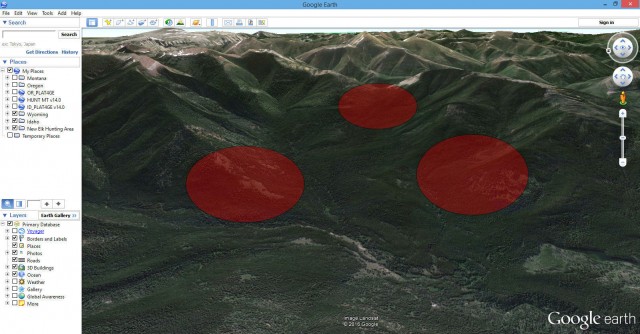 At this point, I am able to narrow the potential hotspots down to just 3 or 4 locations within the original area. I mark them with Placemarks and transfer the waypoints to my GPS. Then, I select another 30-40 square mile area and do the same thing again. From there, I locate primary access points, and start making a game plan for hunting several of these key areas in one or two days. If I arrive and the elk simply aren’t in that area, I pull out immediately and go to Plan B.
At this point, I am able to narrow the potential hotspots down to just 3 or 4 locations within the original area. I mark them with Placemarks and transfer the waypoints to my GPS. Then, I select another 30-40 square mile area and do the same thing again. From there, I locate primary access points, and start making a game plan for hunting several of these key areas in one or two days. If I arrive and the elk simply aren’t in that area, I pull out immediately and go to Plan B.
Since that close call in Idaho several years ago, I have not had a season go by where we weren’t able to locate elk within 2 days in a multitude of different states and areas, all on public land. Being mobile and having several backup areas is the key, but the real value is established in the time that I spend scouting these areas from home. I still like to get out and put boots on the ground any chance I get. This can confirm the information and features I’ve researched from home and will definitely eliminate areas that don’t hold elk, but it isn’t critical.
As I mentioned at the beginning, I am just about finished with the big elk hunting project I have been working on for the last 9 months. It will include over 30 years of elk hunting knowledge and experiences, and it will definitely go into incredible detail on all of the top 3 questions that were asked in response to last week’s email. For example, I spend 20 minutes sitting at a computer and use Google Earth to walk you through how I scout an actual area that I am looking at for this fall. I go through all the steps listed above, plus several more. I’m banking my success this fall – and the success of my hunting partners – on that specific scouting. Plus, I’ll also highlight several other resources that can be used in conjunction with Google Earth to take your remote scouting to a whole new level.
The project is going to be finished up this week, and I’m excited to be able to officially share it with you once it’s done. In fact, I’m planning on making it available on Wednesday June 1 (just 9 days away!)….so mark your calendars! Until then though, I want to share more of the information I’ve included in the project.
So, I need more of your comments to help me dial in exactly what you want to learn when it comes to calling. Is it how to use calls, how to interpret the calls of elk, how to know what to say to the elk? Leave your response in the comments area below, and I’ll read through them and send out another email in a day or two with some thoughts on your questions/concerns. Plus, I’ll randomly pick 10 winners from those new comments and send them each a University of Elk Hunting DVD!
Before I forget, here are the 20 winners from last week’s comments:
Mike Barnes
Vince Lindgren
Chris N Jackie Girdner
Dialedinhunter
Montan16
Armourbearer21
Tim Barlow
Mike Hillberg
Jonas
Scott T Sgambati
Reed Klearman
SMR30549
Jacob Robinson
Clayton Hoover
Peter George
Kurt Rojemann
Travis Kohlrus
Mark Gerdes
Chris Taylor
Bradley Stark
If your name is on the list above, shoot me an email at corey@elk101.com with your mailing address, and I’ll get a diaphragm call dropped in the mail and headed your way. Please respond by Wednesday (May 25th)…otherwise, I’ll pick another winner and send the call to them.
Again, your responses are incredibly helpful as I put the final touches on this project. I absolutely want your input so I can make sure the information I include will drill deeply into the concerns and questions you have when it comes to elk hunting. The entire purpose for this project is to increase your success in elk hunting, and I want to make sure any concerns you have, or any gaps in knowledge or confidence you feel, are not only addressed, but resolved.
So, let me know the specifics of what you want to learn when it comes to calling: Is it how to use calls, how to interpret the calls of elk, how to know what to say to the elk? Leave a comment below, and I’ll read through them and send out another email with some thoughts (and a list of the DVD winners) on Wednesday.
P.S. Make sure you mark your calendar for Wednesday June 1 when I launch my new elk hunting project!
